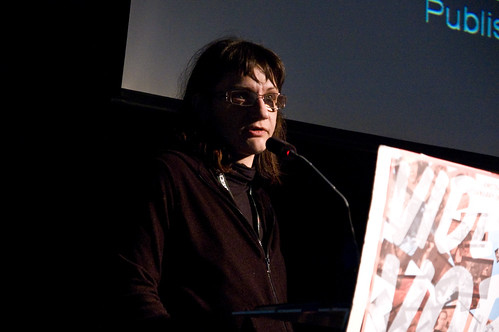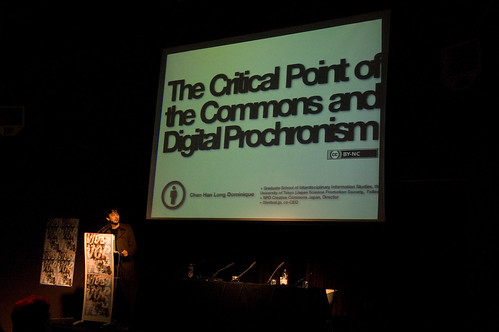Video Vortex: Participatory Culture
Do you think Participatory Culture is all about friendly cooperation? Fans flocking to Star Wars conventions or squad based play in the latest MMORPG? The Participatory Culture session at the international Video Vortex conference in Amsterdam, proved that practices such as “cutthroat capitalism” also belong in this category. And how can, from an Asian instead of a Eurocentric perspective, the changing concept of authorship be understood when everyone can build new meaning upon an original work? This session provided practical examples as well as theoretical context.
Tilman Baumgärtel: Cutthroat Capitalism in South East Asia
First presenter Tilman Baumgärtel, currently teaching at the College of Mass Communication of the University of the Philippines in Manila, discussed piracy and intellectual property in South East Asia. Having organised the Asian Edition conference, which deals exactly with this subject, Baumgärtel can be regarded as an expert on these ‘social economics of piracy’. Surprisingly, however, these questions do not involve Internet and P2P data communication. Baumgärtel explains: ‘Asian piracy is still largely based on disk because there aren’t a lot of fast internet connections and modems’.

To give the audience an impression of the context, Baumgärtel shows a trailer of Malaysian film Ciplak (translation: Fraud). This independent film deals with the subject of piracy and it is one of the few comedies that is accessable to audiences in the region, also because indie films usually deal with ‘more serious subjects’. In the production process of Ciplak, creativity was necessary because of the low budget. For example, everyone worked on the movie free of charge, a camera was bought that came with 10 free mini-DV tapes and IKEA lamps were used for lighting.
Malaysian piracy started in the 1980s with the advent of VHS pirating and continued in the 1990s with VCD pirating. Baumgärtel: ‘Piracy started as a counter-movement against poor distribution. In Europe you can find almost anything, in Asian countries, however, films are hard to find.’ Only Hollywood films, or films starring Jackie Chan, make it through to cinemas and the legal distribution circuit. Baumgärtel: ‘This changed with VHS and BetaMax piracy. Some of the film makers feel that they are so indepted to the pirates, that this group is already thinking about contacting pirates so they can use their distribution channels. Internet is not a factor in this yet because of low speeds’.
These distribution channels are inventive and constitute a grassroots movement. In order to provide consumers with product, fishermen are smuggling masterdisks in the belly of tunafish. Global piracy is a consequential response to global economy, Baumgärtel: ‘The recent process of privatization has taken its part in facilitating piracy’. And continuining: ‘This is globalization from below. It is not about legal organisations, but illegal outfits. This movement represents globalized business and takes advantage of infrastructures. It is the counter image of legal illicit globalization we are seeing right now’. A term Baumgärtel mentioned in response to questions afterwards, perhaps exemplifies this movement most vividly. This is about ‘Cutthroat Capitalism’.
Ana Peraica: Food markets and copyright infringement
In her presentation, Ana Peraica, freelance curator and theorist mostly engaged with video and new media, gives an analysis of the growin archive of illegal material with a focus on Croatia. Why this region? Peraica: ‘Croatia is a really interesting region, because piracy is not really regarded as a crime’. She continues: ‘The problem of copyright was introduced to Croatia in 1991, before that it was still silent online. Today you can find illegal copies, for example, on the food market’.
On a more personal note I came across this example on a recent trip to Split, Croatia. Boulevards were crowded with stands selling illegal copies of the newest computer games and Hollywood films. Once installed, games were often older versions of the same franchise and films turned out to be bad recordings of cinema screens. Peraica: ‘I would like to show some examples in my presentation today, but the problem is that this would be illegal here. There is no agency that hunts down piracy in Croatia, they simply don’t bother about objections of copyright’.

Continuing, Peraica asks herself the question: ‘Is everyone who possesses a video camera and publically exposes video, automatically a video artist?’ Both an interesting and strange case, exemplifying duality in this question, is that of Croatian popstar Severina. She recorded a pornographic video of herself that got published online without her consent, she claimed copyright and stated that is was video art. Severina’s lawyer also stated that home video pornography is video art. The court’s response was that it was nothing innovative and therefore not video art. Severina lost this case, but at the same time she saw her popularity rising. The lawyer also put forth that it was invading privacy, the court responded by stating that she recorded it herself.
‘What is still video art?’ Peraica continues. Does it have to be innovative and perhaps even elitist? Peraica: ‘Popular culture is recycling elite culture, but is it still art?’ In her final words, Peraica concludes that is hard, if not impossible, to define art as something downloaded from YouTube versus institutionalized art.
Dominick Chen: Redefining Authorship from an Asian perspective
In his presentation Dominick Chen, who leads Creative Commons Japan and is JSPS Fellow Researcher at the University of Tokyo and NTT InterCommunication Center, aims to propose a redefinition of authorship itself: ‘How can we gain understanding of data generation and distribution in the light of systems?’ And more specifically, how to go through this Eurocentric idea of individual authorship, or commons? Chen aims to redefine the ‘commons’ from an Asian point of view. Especially with regards to the chain of creativity, where Asian culture differs greatly from its European counterpart.
Chen starts with an example of piracy and participatory culture in India: ‘When you buy a DVD in India, through a Chinese hack, you can get three stories: English, Chinese and Indian. Because translation of subtitles is really bad, you get three different stories based on one film’. Another example of a big Japanese market where you can secondary work of comics, anime and novels, Chen: ‘ There are about 50.000 participants who are selling product themselves, they gather to buy eachothers works that have been derived from original works.

The result is ‘fifty million Yen of economical effect in just three days’. Contributing to an original artwork, going from monologue to dialogue, is an essential part of Japanese culture. Chen: ‘Creativity is considered as reflective to the original author, contributors don’t care about being part of the chain of creativity’. This is exemplified in the fact that on Japanese Wikipedia, 80% of users are acting anonymous. This is the exact opposite of Wikipedia use in the United States. Chen: ‘This chain of creativity, based on anonymity mous is very characteristic of Japanese culture.
Looking back, Chen remembers 2007 firstly as the year of the fight between users and existing shareholders of the broadcasting industry. Secondly, 2007 saw the birth of the metadataplatform, which Chen calls ‘a critical point in classical User Generated Content’. Envisioning 2008, Chen firstly sees an explosion of open contents and, secondly, the rise of the ubiquitous platform of data and creation, such as the iPhone and the Nintendo DS. A third essential vision for 2008 is the recursive stratification – indefinite division into subgroups- of web API with the appearing of “API’s of API’s”. Fourth, Chen predicts a ‘war over openness, which platform can be more open than the other one?’
As an example of Japanese culture and the chain of creativity mentioned earlier, Chen shows Japanese videosharing service Nico Nico Douga. By analyzing this video service, Chen wants to clarify what creativity is in this whole situation. He concludes that comments are ‘becoming constituents of the original work, affecting both authorship and spectatorship. It is a shift from dialogue to symlogue, because narrative control is shared and over time content is nurtured, fermentative’. As examples of symlogue, he mentions M.C. Escher’s Drawing Hands, where both hands share narrative control and are also fermentative of nature. On Nico Nico Douga, a movement has emerged that uses original material and builds upon it by using, for example, the VOCALOID sound plugin.
Chen emphasizes that he doesn not want to focus on horizontal effects, or the chain of creativity, but he asks himself the question of ‘how to open this up on a vertical level?’ For a recent exhibition, Chen cooperated with a well-known Japanese author, who wrote a new book on the spot. New chapters could be downloaded through the Internet. Chen: ‘Normally it is considered embarassing to show how a writer writes. By showing this process, a new relationship between reader and author is created’. Chen also shows a recording of twenty-four hours of editting on a single Wikipedia page. This ‘opening up of revision’, is what Chen regards as the next step in opening up the ‘commons’. It exemplifies the ‘open ecology of digital contents’ and ‘fermentative ecology’ that Chen mentions in his final words.
Report by Twan Eikelenboom
All photography by Anne Helmond